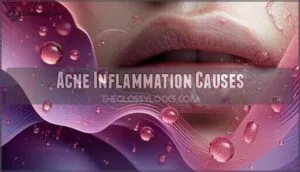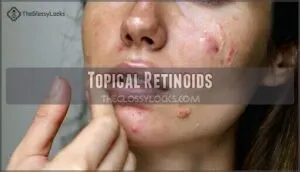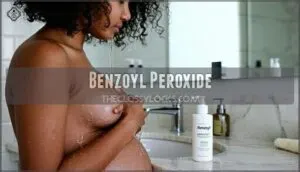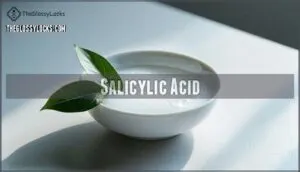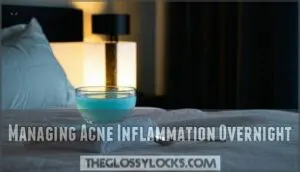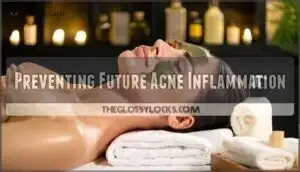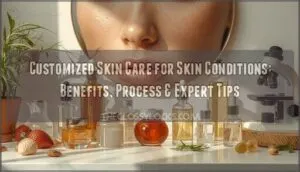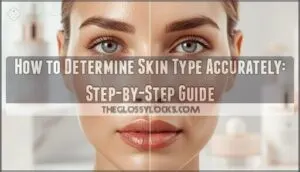This site is supported by our readers. We may earn a commission, at no cost to you, if you purchase through links.
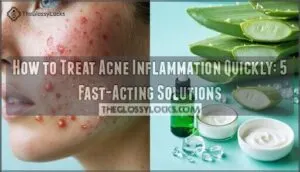 You can tackle acne inflammation fast by targeting the root cause head-on.
You can tackle acne inflammation fast by targeting the root cause head-on.
Apply a cold compress for 10-15 minutes to reduce swelling, then follow with a spot treatment containing benzoyl peroxide or salicylic acid.
These ingredients work like firefighters, dousing the inflammatory response while fighting bacteria. Tea tree oil offers a gentler alternative that’s equally effective.
Don’t pick or squeeze—this only fans the flames. Instead, dab on some aloe vera gel for its cooling, anti-inflammatory properties.
Within 12-24 hours, you’ll notice significant improvement in redness and pain. The secret lies in combining immediate relief with proven acne-fighting ingredients for maximum impact.
Table Of Contents
- Key Takeaways
- Acne Inflammation Causes
- Treating Acne Inflammation Quickly
- Reducing Acne Redness Fast
- Managing Acne Inflammation Overnight
- Preventing Future Acne Inflammation
- Frequently Asked Questions (FAQs)
- How do you get rid of inflammatory acne fast?
- How to reduce acne inflammation overnight?
- How long does it take for acne inflammation to go away?
- How to reduce acne redness asap?
- What are the best natural acne remedies?
- How does diet influence acne and inflammation?
- Can acne scars form if untreated promptly?
- What is the role of gut health in acne?
- Are there environmental triggers for acne inflammation?
- Conclusion
Key Takeaways
- Apply ice first, then spot treat – Use a cold compress for 10-15 minutes to reduce swelling, then follow with benzoyl peroxide or salicylic acid to fight bacteria and calm inflammation within 12-24 hours.
- Don’t pick or squeeze inflamed acne – Picking worsens inflammation and increases infection risk, so instead dab on aloe vera gel for its cooling, anti-inflammatory properties that help heal angry pimples naturally.
- Use tea tree oil as a gentle alternative – Apply diluted tea tree oil (5% concentration) twice daily as a natural antibacterial treatment that can reduce pimples by 3.55 times without harsh side effects.
- Prevent future breakouts with consistent habits – Stick to non-comedogenic products, exfoliate 2-3 times weekly with salicylic acid, and manage stress through meditation or exercise to control oil production and inflammation cycles.
Acne Inflammation Causes
Understanding what causes acne inflammation helps you choose the right treatment approach.
Your skin becomes inflamed when excess oil production, bacterial overgrowth, dead skin cell buildup, and hormonal changes work together to create red, swollen breakouts, which is a key factor to consider for the right treatment approach.
When excess oil, bacteria, and dead cells team up, your skin fights back with angry, inflamed breakouts.
Excess Sebum Production
Your sebum glands work overtime when androgens flood your system, pumping out excess oil that clogs follicles instantly.
Genetic factors determine how much your glands produce, while certain foods can trigger even more activity.
This oily buildup creates the perfect storm for inflammation, making follicle clogging inevitable.
Understanding sebum gland activity helps you reduce acne inflammation with targeted fast acne treatment approaches.
Bacterial Overgrowth
When harmful bacteria multiply on your skin, they trigger the inflammatory cascade that creates those angry red bumps.
Bacteria feast on trapped oil, launching the inflammatory attack that turns clear skin into a battlefield of angry, swollen breakouts.
Propionibacterium acnes (P. acnes) thrives in clogged pores, feeding on excess oil and dead skin cells.
Key factors driving bacterial overgrowth include:
- C. acnes strains developing antibiotic resistance from overuse
- Microbiome balance disruption allowing harmful skin bacteria to dominate
- Topical antimicrobials becoming less effective against resistant P acnes
Hyperkeratinization
Understanding hyperkeratinization helps you tackle acne at its root.
Your skin produces too many dead cells, creating keratinocyte buildup that blocks pores completely.
This genetic factor affects skin cell turnover, trapping oil and bacteria inside follicles.
Regular exfoliation methods can reduce acne inflammation by clearing these cellular roadblocks, providing quick acne relief and preventing future pimple swelling naturally, which involves hyperkeratinization and cellular processes.
Hormonal Imbalances
Hormonal changes trigger your body’s oil production to go haywire. Androgen excess from conditions like PCOS acne creates perfect storm conditions.
When estrogen levels drop, sebaceous glands pump out more oil than necessary. This hormonal chaos feeds inflammation cycles.
Lifestyle choices also affect acne development.
- Androgen excess stimulates excessive sebum production in hair follicles
- PCOS acne results from insulin resistance and elevated male hormones
- Birth control pills help regulate estrogen levels and reduce breakouts
- Spironolactone blocks androgen receptors to decrease oil production
- Hormonal therapy targets root causes rather than surface symptoms
Treating Acne Inflammation Quickly
When inflamed acne strikes, you need fast action to regain control over your skin.
Ice becomes your first line of defense – wrap a cube in a clean cloth and hold it against the swollen area for 10-15 minutes to reduce pimple swelling immediately.
Spot treatments containing benzoyl peroxide or salicylic acid work overnight to calm acne redness and treat painful acne effectively.
Your diet plays a vital role too – cut back on dairy and high-glycemic foods that trigger inflammation.
Hydration helps flush toxins while supporting your skin’s natural healing process.
Don’t underestimate sleep’s power for rapid acne recovery; your skin repairs itself most efficiently during those precious seven to nine hours.
To further combat acne, consider how consistent sleep patterns can aid recovery.
This inflamed pimple remedy approach tackles inflammation from multiple angles, giving you the liberation from painful breakouts you deserve.
Reducing Acne Redness Fast
When you’re dealing with angry red pimples, you need treatments that work fast to calm the inflammation and reduce the visible redness.
The right combination of topical treatments can substantially decrease redness within hours, helping you regain confidence while your skin heals, which is crucial for dealing with angry red pimples.
Topical Retinoids
Beyond quick fixes, topical retinoids offer powerful long-term benefits for acne inflammation.
These vitamin A derivatives reduce inflamed acne by unclogging pores and boosting cell turnover. You’ll find different retinoid types like adapalene and tretinoin available.
Apply a thin layer nightly, starting slowly to minimize side effects like redness and peeling that typically subside with continued use.
Retinoids also play a key role in regulating skin tone, providing acne inflammation reduction and long-term skin health improvement through topical application.
Benzoyl Peroxide
Most people find benzoyl peroxide kills acne-causing bacteria while reducing pimple swelling effectively.
Start with 2.5% concentration to test your skin’s tolerance before increasing strength. Apply this antiinflammatory acne treatment once daily, as higher benzoyl concentration doesn’t always mean better results.
Watch for benzoyl side-effects like redness or peeling. Consider benzoyl alternatives if irritation persists despite proper benzoyl application techniques.
Many retailers offer benzoyl peroxide 2.5 products.
Salicylic Acid
Salicylic acid offers powerful acne inflammation control through its antiinflammatory properties and acid exfoliation benefits.
This beta-hydroxy acid excels at pore unclogging, making it ideal for blackhead treatment and whitehead removal.
You’ll see inflammation reduction as it penetrates deep into follicles, dissolving buildup that triggers breakouts.
For more on this topic, explore product options.
For acne treatment and acne reduction, salicylic acid delivers consistent results.
Gentle Skincare Routine
When dealing with angry breakouts, your cleansing techniques matter more than you think.
Choose gentle, non-comedogenic products that won’t aggravate inflamed skin. Follow proper product selection by avoiding harsh scrubs that increase irritation.
Moisturizing importance can’t be overstated—it maintains your skin’s barrier while you reduce pimple swelling.
Daily sunscreen use protects healing skin, and routine consistency delivers the most effective acne calming results, highlighting the need for gentle care.
Managing Acne Inflammation Overnight
When you wake up with angry, inflamed acne, you need treatments that work while you sleep to reduce swelling and redness by morning.
These overnight remedies target inflammation directly, helping calm irritated skin and minimize the appearance of breakouts when you start your day, which can be achieved with treatments that work to reduce inflammation.
Cold Compresses
A cold compress works like a natural anti-inflammatory for angry pimples. The ice application constricts blood vessels, which reduces pimple swelling and helps calm acne redness instantly.
Some users find specialized acne products useful in conjunction with cold compresses.
To use a cold compress effectively, follow these steps:
- Wrap ice cubes in a clean cloth for compress material
- Apply gentle pressure for 5-10 minutes compress duration
- Use twice daily for inflammation control
- Never place ice directly on skin, as it can cause damage, and instead opt for a gentle, cold compress application.
Tea Tree Oil
Tea tree oil offers a natural acne inflammation solution that’s been trusted for centuries. This botanical powerhouse can calm acne redness through its antibacterial properties, making it perfect for overnight treatment.
Apply diluted tea tree oil twice daily for ideal TTO benefits. Start with 5% TTO concentration to minimize TTO side effects while maintaining effectiveness.
As a natural remedy, it’s known for its antimicrobial properties.
| TTO Application Method | Expected Results |
|---|---|
| Direct spot treatment | Reduces inflammation within 12 hours |
| Mixed with moisturizer | Gentler approach for sensitive skin |
| Pre-diluted products | Convenient option with consistent concentration |
TTO research shows impressive results – one study found a 3.55-fold reduction in pimples. However, always patch test first, as some people experience irritation. Never ingest tea tree oil, and avoid eye contact.
This acne inflammation control method works best for mild to moderate breakouts, helping soothe acne skin naturally overnight.
Aloe Vera Gel
Aloe vera gel offers natural acne inflammation control by delivering cooling relief to angry pimples.
This plant-based solution helps heal inflamed skin while reducing acne irritation through its anti-inflammatory compounds. Epsom salt baths can further support the skin’s barrier function.
- Fresh leaf extraction: Cut aloe leaf, scoop clear gel, apply directly to breakouts
- Store-bought application: Choose 99% pure aloe gel, avoid added fragrances or dyes
- Overnight treatment: Layer thin coat over clean skin, let absorb completely
Avoiding Picking or Squeezing
While aloe vera soothes inflamed skin, resisting the urge to pick or squeeze acne lesions is equally important for scarring prevention and infection risk reduction.
Your hands carry bacteria that worsen inflammation control and disrupt the healing process.
Touching inflamed acne increases psychological impact by prolonging breakouts.
Keep hands busy with stress balls to reduce acne irritation and calm angry pimples naturally, which helps in infection risk reduction.
Preventing Future Acne Inflammation
Once you’ve treated current inflammation, you’ll want to establish habits that prevent new breakouts from forming.
The key is maintaining consistent skincare practices and making simple lifestyle changes that address the root causes of acne inflammation, which is crucial for preventing future inflammation.
Non-Comedogenic Products
Choosing noncomedogenic products requires careful ingredient analysis and product labels scrutiny.
These formulations won’t clog your pores, making them essential for sensitive skin prone to inflamed acne.
Look for specific brands that emphasize formulation science behind their best acne antiinflammatory ingredients.
Products labeled "noncomedogenic" help reduce acne irritation and calm angry pimples by preventing pore blockage that triggers inflammation.
Oil-Free Moisturizers
Your skin craves balance, not deprivation.
Oil-free moisturizers provide essential hydration benefits without triggering inflamed acne or worsening redness and swelling.
Look for ingredients like hyaluronic acid and niacinamide in product recommendations.
These acne anti-inflammatory formulas maintain skin balance while preventing excess sebum production.
Apply gently using upward motions twice daily for ideal ingredient analysis results.
Regular Exfoliation
Dead skin cells pile up like unwanted guests at your pores’ party.
Regular exfoliation removes this buildup, preventing clogged follicles that trigger acne inflammation.
Chemical exfoliants like salicylic acid work gentler than physical exfoliation methods for sensitive skin.
Exfoliate 2-3 times weekly to maintain clear pathways without irritation.
Consistent exfoliating reduces future breakouts and supports antiinflammatory acne treatment effectiveness.
Stress Management Techniques
Managing stress effectively can break the cycle of acne breakouts and inflammation.
When cortisol levels spike, your skin produces more oil, creating perfect conditions for bacterial overgrowth.
Deep breathing and mindfulness practices help regulate these hormones naturally.
- Practice meditation techniques for 10-15 minutes daily to reduce cortisol production
- Incorporate regular exercise benefits like yoga or walking to release tension naturally
- Maintain proper sleep hygiene with 7-9 hours nightly for ideal skin repair
- Use mindfulness practices during stressful moments to prevent stress-induced breakouts
- Apply deep breathing exercises when you feel overwhelmed to calm your nervous system
Frequently Asked Questions (FAQs)
How do you get rid of inflammatory acne fast?
Think of acne like an unwelcome guest overstaying its welcome.
Soothe inflammation fast with ice packs, apply benzoyl peroxide or salicylic acid creams, and wash gently twice daily.
Avoid popping pimples to prevent scarring.
How to reduce acne inflammation overnight?
Apply a cold compress to calm redness, then use a spot treatment with benzoyl peroxide or salicylic acid.
Avoid touching or squeezing pimples, and keep your skin moisturized with a lightweight, non-comedogenic product.
How long does it take for acne inflammation to go away?
Acne inflammation usually fades within a few days to a week, depending on severity and treatment.
Supporting your skin with soothing products, like aloe vera or hydrocortisone, and avoiding irritation helps speed up recovery, which can be considered a key factor in recovery.
How to reduce acne redness asap?
Nearly 85% of teens face acne redness at some point.
To calm it fast, dab ice wrapped in a cloth for a few minutes, use soothing aloe vera gel, and apply a green-tinted moisturizer.
What are the best natural acne remedies?
Aloe vera soothes irritation and reduces redness, while tea tree oil fights bacteria.
Honey’s antibacterial properties help heal blemishes.
Green tea can calm inflamed skin, and apple cider vinegar balances oil and exfoliates gently.
How does diet influence acne and inflammation?
Your diet affects acne by influencing hormones, inflammation, and oil production.
High-glycemic foods, dairy, and sugars can worsen acne.
Eating nutrient-rich foods, like vegetables, whole grains, and fish, helps balance hormones and reduce inflammation.
Can acne scars form if untreated promptly?
Skipping treatment isn’t a free pass—acne scars show up like unwelcome guests, sticking around far longer than pimples.
When inflammation isn’t handled, your skin’s collagen repairs poorly, leading to scars that are tough to erase.
What is the role of gut health in acne?
Your gut microbiome directly influences skin inflammation through the gut-skin axis.
Beneficial bacteria help regulate immune responses, while imbalanced gut flora can trigger inflammatory pathways that worsen acne breakouts and severity, involving inflammatory pathways.
Are there environmental triggers for acne inflammation?
Environmental factors can definitely trigger acne flare-ups.
You’ll notice pollution, humidity, harsh weather, and certain skincare products worsen inflammation.
Even touching your face frequently transfers bacteria and oils that clog pores, which can lead to inflammation.
Conclusion
Like a well-equipped emergency kit, these fast-acting solutions give you the tools to combat acne inflammation effectively.
You’ve learned how to treat acne inflammation quickly using cold compresses, targeted spot treatments, and gentle alternatives like tea tree oil.
Remember that consistency beats perfection—stick to your routine and avoid picking at breakouts.
Within 24 hours, you’ll see noticeable improvements in redness and swelling.
Your skin deserves this immediate care and attention for lasting results.

